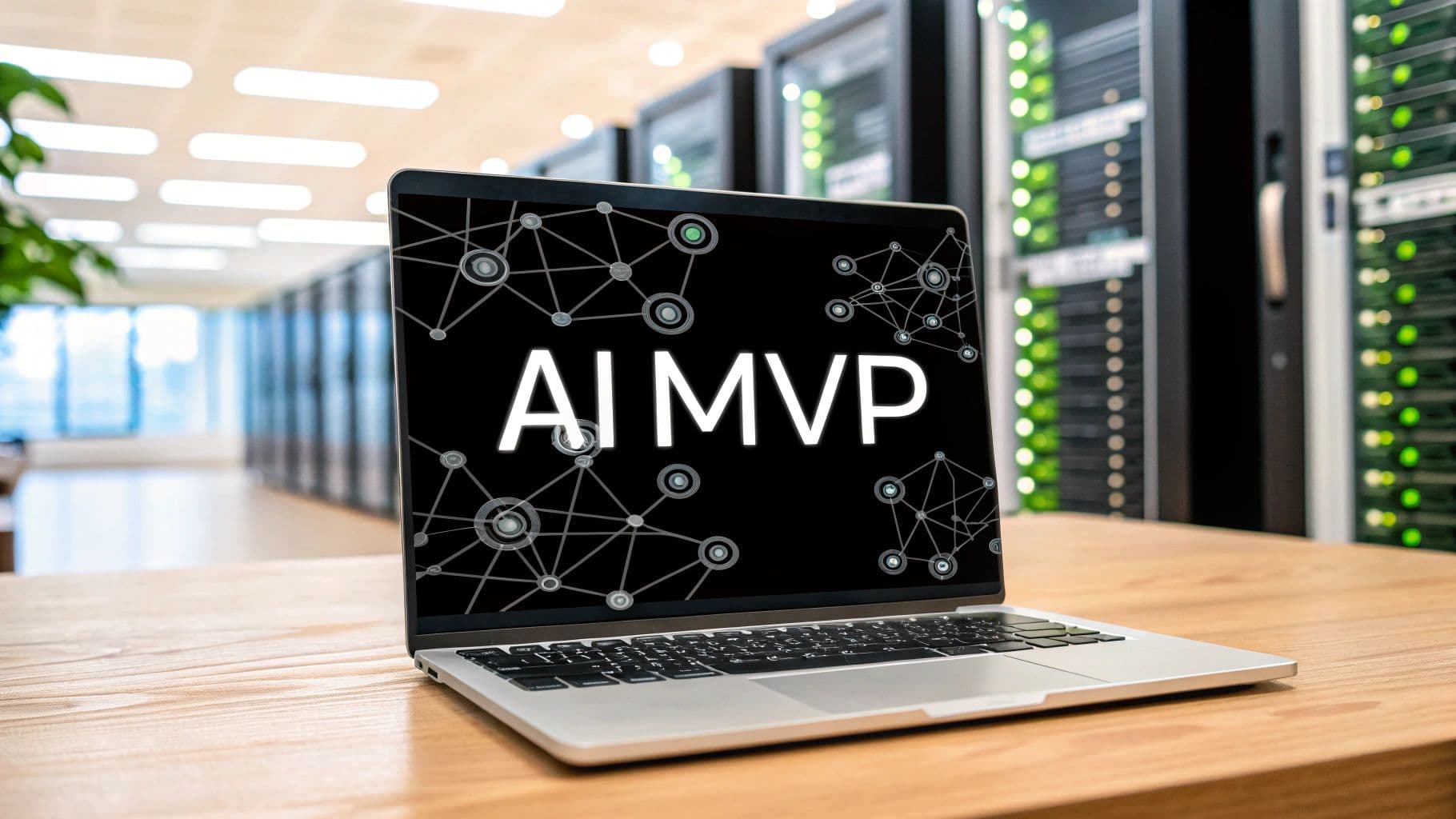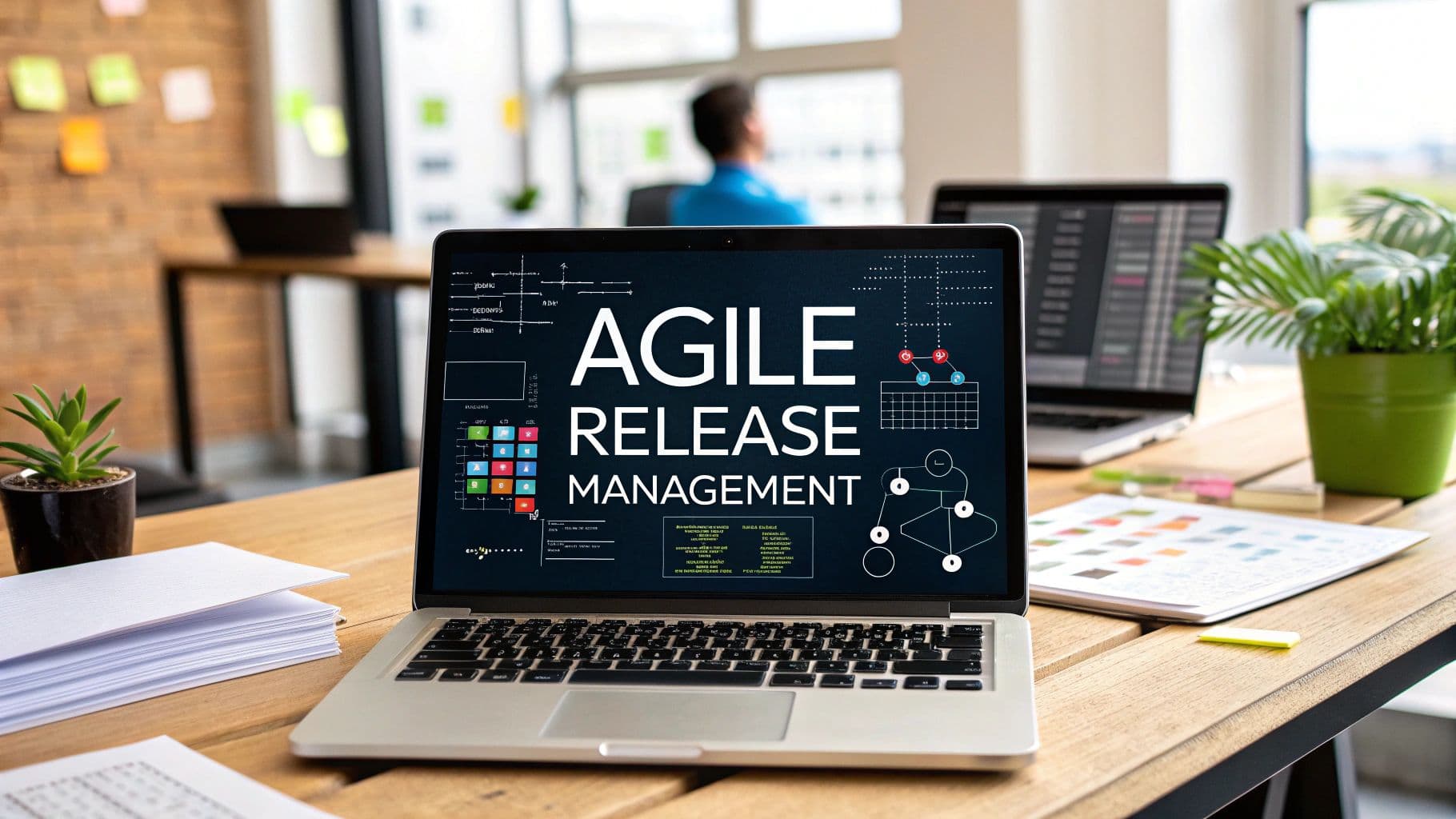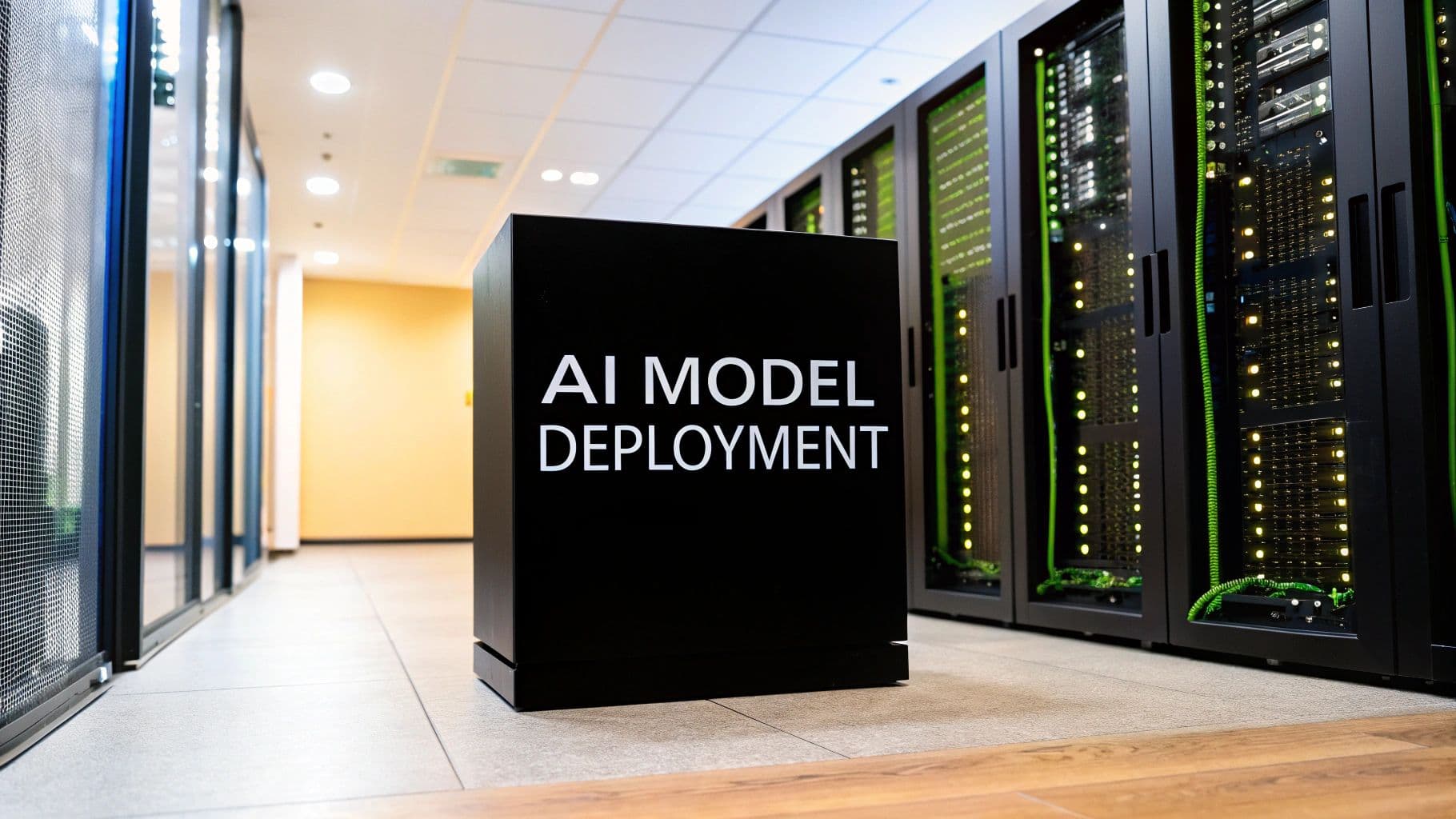ai mvp development
product innovation
startup technology
artificial intelligence
lean development
AI MVP Development: Build Smarter & Launch Faster
The New Playbook: AI MVP Development Fundamentals
Building a Minimum Viable Product (MVP) has always been about validating ideas quickly and efficiently. Traditional MVPs, however, can sometimes miss the subtleties of user behavior and struggle to keep up with rapid technological change. This is where AI MVP development offers a fresh approach, a new playbook for building smarter and launching faster. With AI, you can create MVPs that not only validate core functions but also learn and adapt, providing valuable insights from the very beginning.
Understanding the Power of AI in MVP Development
Adding AI to your MVP development process isn't about chasing the latest trends; it's about fundamentally changing how you approach product validation. AI offers the ability to personalize user experiences right from launch, letting you test different versions and gather data on what truly resonates with your target audience.
AI can also analyze user interactions in real-time. This allows you to spot patterns and uncover hidden needs that traditional methods might miss. The result is faster iteration and data-driven decision-making, significantly reducing the chance of building a product no one wants.
The rapid growth of the global AI market clearly demonstrates the potential of this technology. With a CAGR of 37.3% projected between 2022 and 2030, the AI market is expected to grow more than five times its current size within the next five years, reaching over $600 billion in 2025. Find more detailed statistics here. This impressive growth highlights the transformative impact of AI across many sectors, particularly in product development. AI-powered MVPs empower businesses to harness this potential and build more effective and adaptable products.
Key Principles of AI MVP Development
Successfully building an AI MVP involves a shift in thinking and a focus on these key principles:
-
Data-centric approach: AI relies heavily on data. Prioritize a solid data strategy from the outset to ensure you collect the right information for training and refining your AI models.
-
Iterative development: Embrace the agile methodology. AI MVPs are constantly evolving. Plan for continuous improvement based on user feedback and data analysis.
-
User-focused design: While AI drives the backend, user experience remains critical. Design your MVP with a deep understanding of your target users and their specific needs.
-
Measurable results: Define clear metrics from the beginning. Track performance diligently and use data to inform your development decisions.
Benefits of AI-Driven MVPs
By following these principles, you can unlock significant benefits:
-
Faster validation: AI accelerates the feedback loop, allowing you to validate your assumptions and adjust your course quickly.
-
Reduced development costs: Focusing on essential features and using AI for personalization and analysis minimizes development time and resources.
-
Enhanced user experience: AI allows for personalized experiences from the first interaction, boosting user engagement and satisfaction.
-
Data-driven insights: Gain deeper insights into user behavior and market trends to inform your product roadmap.
By harnessing the power of AI, you can transform your MVP development process. You can create products that are not only viable but also intelligent and adaptable, setting the stage for lasting success. This new playbook empowers you to navigate the complexities of the market and gain a competitive edge.
Why AI-Powered MVPs Outperform Traditional Approaches
Traditional MVP development often involves a degree of uncertainty. You build a basic product, release it, and hope it aligns with user expectations. This can be a slow, expensive process with disappointing results. Integrating AI, however, transforms MVP development, offering significant advantages. AI-powered MVPs use data to learn and adapt, providing a dynamic and efficient path to product validation.
Imagine developing a language learning app. A traditional MVP might offer basic vocabulary and quizzes. An AI-powered MVP could personalize lessons from the outset, adapting to individual learning styles and providing targeted feedback. This creates a more engaging user experience, leading to higher retention and valuable data for future development.
Furthermore, AI algorithms can uncover hidden patterns in user behavior, identifying popular features, ignored elements, and even predicting future user needs. This data-driven approach enables informed iterations and adjustments to the MVP, increasing the likelihood of creating a market-ready product. The infographic below illustrates the benefits of AI for startups developing MVPs:

As shown, a team analyzes AI dashboards, demonstrating how data-driven insights improve collaboration and decision-making. This shift to data-driven decisions is crucial for the success of AI-powered MVPs. To identify the right technologies, consider exploring various AI MVP approaches, including robust solutions like AI Business Solutions.
Accelerating Validation and Reducing Costs
The Minimum Viable Product (MVP) methodology has become essential for faster innovation and higher product success rates. Organizations using MVP approaches are 62% more likely to have successful product launches. Find more detailed statistics here. AI further enhances MVP development, enabling faster validation at a lower cost. For guidance on validating your startup idea, check out this helpful resource: validating your startup idea.
AI automates tasks that traditionally require significant manual effort, such as user testing and data analysis. This drastically reduces the time and resources needed for initial product validation. Additionally, AI’s ability to personalize experiences allows for more accurate, targeted testing, minimizing the risk of developing unnecessary features.
Building Compelling User Experiences
AI-powered MVPs offer a critical advantage: crafting compelling user experiences from the start. By leveraging AI for personalization and recommendation engines, even basic MVPs can offer highly engaging, tailored experiences. This increases user satisfaction and retention while generating invaluable data about user preferences, further refining product development. These early insights are essential for iterating on your MVP and creating a resonant product. You might find this resource helpful: How to Master Your AI Product Launch.
The following table summarizes the key distinctions between traditional and AI-enhanced MVP development:
Traditional MVP vs. AI-Enhanced MVP Development
This comparison table highlights the key differences between conventional MVP approaches and AI-powered MVP development across various aspects of the product development lifecycle.
| Development Aspect | Traditional MVP | AI-Enhanced MVP | Business Impact |
|---|---|---|---|
| User Feedback | Gathered after launch, often through surveys or analytics | Continuously collected and analyzed in real-time | Faster iteration cycles, improved product-market fit |
| Personalization | Limited or non-existent in initial versions | Highly personalized experiences from day one | Increased user engagement and retention |
| Feature Prioritization | Based on assumptions and market research | Data-driven prioritization based on user behavior | Reduced development costs, focus on high-value features |
| Testing & Validation | Manual testing and analysis | Automated testing and AI-powered analysis | Faster validation, reduced time to market |
| User Experience | Basic and functional | Compelling and tailored | Improved user satisfaction, stronger product differentiation |
AI fundamentally changes early product development economics. By accelerating validation, reducing costs, and enabling compelling user experiences, AI-powered MVPs offer a clear path to building successful products. This empowers teams to navigate market complexities and gain a competitive edge.
Building the Data Foundation That Powers AI Success
The success of your AI Minimum Viable Product (MVP) depends heavily on one key factor: your data strategy. Many vendors won't tell you this, but even the most advanced algorithms are ineffective without a strong data foundation. Building this foundation requires careful planning and execution before any coding begins. This involves understanding your specific needs, structuring data collection for scalability, and establishing ethical guidelines.
Identifying Relevant Data Sources
The first step in building your data foundation is determining which data sources are truly important for your specific AI MVP. This requires a deep understanding of your target users and their pain points. For example, if you're building an AI-powered chatbot for customer service, relevant data sources might include past customer interactions, product documentation, and user feedback. This focused approach ensures you collect only the most relevant data, maximizing efficiency and minimizing irrelevant information.
This targeted approach also helps you avoid collecting massive amounts of unnecessary data, which can lead to inaccurate models and wasted resources. Focusing on quality data from the outset is essential for a successful AI MVP.
Structuring Data for Scalability
Once you've identified your data sources, you need to structure your data collection process for scalability. This means designing a system that can handle increasing volumes of data as your product grows. Think of it like constructing a building: a weak foundation won't support future additions. Similarly, a poorly structured data pipeline will limit your AI MVP's ability to adapt and improve.
A key aspect of this is choosing the right data storage solutions. These solutions must be able to accommodate growth and integrate data cleaning and pre-processing steps to maintain data quality as your project scales.
Implementing Ethical Guardrails
As you build your data foundation, establishing ethical guidelines from the outset is crucial. This protects both your users and your business. Consider issues like data privacy, bias mitigation, and transparency. These aren’t just ethical necessities; they're essential for building trust with your users and ensuring the long-term viability of your AI MVP.
Being proactive about ethics establishes a strong ethical framework for future data usage. This framework will guide your development and contribute to the overall success of your AI MVP.
Overcoming Data Limitations
Even with limited initial datasets, you can still build valuable AI features. Techniques like data augmentation and transfer learning can help you get the most out of your existing data. Data augmentation creates synthetic data based on your real data, expanding your training set and improving model performance.
Transfer learning uses pre-trained models to accelerate your AI development, even with smaller datasets. These strategies allow you to create functioning AI-powered features with limited resources, demonstrating that a strong data foundation is the key to AI MVP success. Explore this topic further.
Choosing AI Technologies That Actually Deliver Value
Skip the endless AI options and focus on what truly matters for your Minimum Viable Product (MVP). This section cuts through the noise, helping you identify AI technologies that genuinely accelerate MVP success. We'll analyze real-world examples and show you how to match AI capabilities to specific user problems. This empowers you to make smart build-vs-buy decisions and keep your project on track.
Matching AI Capabilities to User Problems
Effective AI MVP development hinges on selecting the right AI capabilities for the right problems. This means understanding your target audience and their needs. For example, Natural Language Processing (NLP) could power a product recommendation engine on an e-commerce platform. This allows the engine to understand user queries and suggest relevant items.
However, if you're building a medical imaging tool, Computer Vision would be more appropriate. This technology analyzes images and detects anomalies.
Matching the technology to the problem avoids costly mistakes. It ensures your AI features actually deliver value to the user. This focused approach streamlines development, allowing you to build features that matter.
Evaluating Implementation Complexity
Choosing AI technologies for your MVP requires carefully evaluating the implementation complexity. Some technologies, like pre-trained sentiment analysis models, are relatively easy to integrate. Others, such as building custom machine learning models, require significantly more resources and expertise.
Understanding these differences is crucial for planning and timelines. Choosing a technology beyond your team's current capabilities can lead to delays and cost overruns.
Smart Build-vs-Buy Decisions
One of the most crucial decisions in AI MVP development is whether to build or buy. Building custom AI solutions provides maximum flexibility and control, but it requires substantial resources. Using pre-built APIs and services, like those offered by Google Cloud AI Platform, can significantly accelerate development. However, it might come with limitations.
A balanced approach often combines both. You might use pre-trained models for basic features while building custom models for core, differentiating functionalities. You might be interested in: How to master AI app building. This maximizes efficiency while maintaining control.
Aligning with Long-Term Vision
Always consider your long-term product vision when building your AI MVP. Choose technologies that meet your immediate needs and scale with future goals. This forward-thinking approach prevents costly rework later.
For example, a flexible, cloud-based AI platform allows you to expand your AI capabilities as your product and user base grow. This scalability is essential for sustained growth and adaptability.
A Practical Framework for Technology Selection
To help guide your decision-making process, we've put together a practical framework for evaluating potential AI technologies. The following table provides a structured approach:
AI Technology Selection Framework for MVPs
This table provides a structured approach to evaluating different AI technologies based on implementation complexity, resource requirements, and typical use cases for MVP development.
| AI Technology | Implementation Complexity | Resource Requirements | Best MVP Use Cases | Limitations |
|---|---|---|---|---|
| Pre-trained NLP Models | Low | Low | Sentiment analysis, chatbots, text summarization | Limited customization |
| Computer Vision APIs | Medium | Medium | Image recognition, object detection, image tagging | Model accuracy may vary |
| Custom Machine Learning Models | High | High | Highly specialized tasks, unique datasets | Requires significant development time and expertise |
By following this framework, you can avoid technological rabbit holes and build a successful AI MVP. Prioritize practicality, selecting technologies aligned with both immediate needs and your long-term vision. This delivers genuine AI advantages without derailing your timelines. Focus on delivering real user value, and you'll be well on your way to building a product that truly resonates with your target audience.

From Concept to Launch: Executing Your AI MVP Roadmap
Theory is important, but practical execution is the key to success. This section provides a practical guide to taking your AI MVP from initial concept to a real-world product, based on the experiences of successful teams. We'll explore building a cross-functional team, structuring development sprints, and setting milestones for AI projects. We'll also discuss navigating the unique challenges of AI development, offering practical solutions to common roadblocks.
Assembling Your AI MVP Team
Even on a tight budget, assembling the right team is critical for AI MVP development. This means combining AI expertise with practical product development experience. Consider these key roles:
- AI/ML Engineer: Responsible for building and training the AI models.
- Software Engineer: Develops the application and integrates the AI models.
- Product Manager: Defines the product vision, prioritizes features, and manages the overall roadmap.
- UX/UI Designer: Creates intuitive and engaging user interfaces.
- Data Scientist (Optional): Valuable for advanced data analysis and model optimization.
This cross-functional approach ensures every aspect of the AI MVP, from model performance to user experience, receives the attention it deserves.
Structuring Development Sprints for AI
AI development often requires a more flexible approach to sprints than traditional software projects. Model training, data collection, and evaluation can introduce unexpected delays. Adaptive sprints, which allow for adjustments based on the evolving needs of the AI components, are generally more effective.
This means regularly reviewing sprint goals and adjusting timelines as needed. This flexibility helps maintain momentum and prevents the project from becoming stalled by unexpected roadblocks.
Establishing Meaningful Milestones
Clear milestones are essential for keeping your AI MVP development on track. These milestones should be SMART: Specific, Measurable, Achievable, Relevant, and Time-Bound. For example, a milestone could be "Train a sentiment analysis model with 80% accuracy by the end of Q1."
This provides a clear target and facilitates tracking progress. It also helps in identifying any potential issues early on. You may find this resource helpful: Understanding LLM Pricing.
Navigating the Challenges of AI Development
AI MVP development presents unique challenges compared to traditional software development:
- Data Acquisition and Preparation: Gathering and cleaning sufficient, high-quality data can be time-consuming and require significant resources.
- Model Training and Evaluation: This process often involves experimentation and iterative refinement, which can be difficult to predict.
- Deployment and Monitoring: Deploying and monitoring AI models requires specialized infrastructure and expertise.
Addressing these challenges requires careful planning and appropriate tools. For example, using cloud-based AI platforms like Amazon Web Services (AWS) or Google Cloud Platform (GCP) can streamline deployment and ongoing management.
Managing Expectations and Avoiding Feature Creep
The excitement surrounding AI can lead to a desire to implement numerous features. However, for an MVP, focusing on core functionalities is paramount. Avoid feature creep by prioritizing the features that directly address your core user need.
This focused approach minimizes development time and resource expenditure. It ensures you launch a usable and valuable MVP quickly, getting your product into the hands of users sooner.
Maintaining Team Momentum
AI development can be demanding, with inevitable technical setbacks. Maintaining team morale throughout the process is crucial. Celebrate small victories, encourage open communication, and foster a culture of continuous learning. This helps keep the team motivated and productive.
By following these steps, you can successfully navigate the complexities of AI MVP development and launch a product that delivers real value. This practical approach to execution, combined with a clear understanding of the inherent challenges, sets the stage for a successful launch and continued growth. Remember, execution is where innovation truly comes to life.
Measuring What Matters: AI MVP Metrics That Drive Growth
Forget vanity metrics. Focusing on the right key performance indicators (KPIs) is crucial for validating your AI MVP. Analyzing successful and failed AI products reveals the importance of establishing robust measurement frameworks. These frameworks must capture both technical performance and real business impact. This involves understanding AI-specific metrics in business terms, designing effective experiments, and balancing quantitative data with qualitative feedback.
Translating AI Metrics into Business Value
A common pitfall in AI MVP development is focusing solely on technical metrics like model accuracy. While important, these metrics don't always translate directly into business value. For example, a model with 90% accuracy in classifying images might not improve customer satisfaction. This can happen if those classifications don't lead to a better user experience.
Instead, focus on metrics tied to business outcomes. These might include conversion rates, customer retention, or task completion time. Focusing on these outcomes ensures your AI MVP delivers tangible benefits. This shift in focus requires translating technical metrics into a language your stakeholders understand.
For example, explaining how improved model accuracy leads to faster customer service response times can illustrate value. If this faster response time then leads to increased customer satisfaction, the value proposition of the AI MVP becomes clear.
Designing Effective Experiments for AI MVPs
Validating your AI MVP requires carefully designed experiments. These experiments should provide statistical confidence without needing excessive data. Techniques like A/B testing can be invaluable. By comparing different versions of your AI features, you can isolate the impact of specific changes.
This method allows you to see which approaches resonate most with your users. This iterative process allows you to refine your AI MVP based on real-world data. When executing your AI MVP roadmap, you might find inspiration from this Roadmap example. This resource can help guide your planning and execution.
Balancing Quantitative Data with User Feedback
While quantitative data is essential, don't underestimate the power of qualitative user feedback. Gather insights through user interviews, surveys, and feedback forms. This qualitative data provides context for quantitative metrics. It reveals why users behave in certain ways.
For instance, high user engagement with a particular feature might be due to its novelty. The engagement could stem from the novelty rather than the feature's actual usefulness. This valuable insight would be missed with quantitative data alone. Combining these two perspectives – quantitative and qualitative – provides a holistic understanding of your AI MVP's performance. This leads to data-backed, user-centric improvements.
Avoiding Premature Optimization and Driving Targeted Improvements
A common trap in AI MVP development is premature optimization. Focusing on fine-tuning your model before validating core functionalities can lead to wasted effort. Instead, prioritize rapid iteration and testing. Focus on demonstrating value quickly. Use measurement insights to identify areas for improvement and target your efforts effectively.
This data-driven approach avoids wasting resources on features that don't add significant value. It keeps your development aligned with user needs and business objectives.
Measuring Long-Term Success
As your AI MVP evolves, your metrics should too. Initial metrics might focus on basic functionality and user engagement. As your product matures, shift your focus to metrics related to long-term sustainability and business growth. This continuous evolution of your measurement framework ensures your AI MVP stays aligned with your overall business objectives.
By focusing on the right metrics, designing effective experiments, and incorporating user feedback, you can build an AI MVP that not only validates your initial concept but also sets the stage for sustained growth and market success. Remember, measuring what matters is the key to unlocking the true potential of your AI-powered product.
Beyond MVP: Scaling Your AI Product For Market Dominance
Launching a successful Minimum Viable Product (MVP) is a significant achievement. However, it's only the first step. Transforming a promising MVP into a market-leading product requires a strategic approach to scaling both your technology and your team. This involves expanding AI features without compromising performance, handling increasing data volumes, and building a robust technical architecture.
Expanding AI Features While Maintaining Performance
As your user base grows, so will the demand for new and improved AI features. However, simply adding features without considering performance can negatively impact the user experience. For example, adding complex image processing to an app initially designed for text analysis could significantly slow down response times if the underlying architecture isn't prepared.
This highlights the importance of scalable infrastructure. Using cloud-based services like Amazon Web Services allows you to dynamically allocate resources as needed, ensuring consistent performance as your AI features expand.
Navigating The Challenges of Growing Data Volumes
One of the biggest challenges in scaling an AI product is managing the exponential growth of data. As more users interact with your product, the volume and diversity of data generated can quickly overwhelm your initial infrastructure.
This demands robust data management strategies. Implementing efficient data pipelines and storage solutions, along with techniques like data sharding and distributed processing, are crucial for handling these growing volumes efficiently.
Building a Technical Architecture For Sustainable Growth
Scaling your AI product requires a robust technical architecture designed for sustainable growth. This involves choosing technologies that can handle increasing loads, ensuring seamless integration between different components, and implementing effective monitoring and maintenance processes.
For instance, shifting from a monolithic architecture to a microservices approach can provide greater flexibility and scalability. This allows different teams to work on and deploy features independently, accelerating development and reducing risk.
Maintaining Model Accuracy As Usage Patterns Evolve
User behavior rarely remains static. As your user base expands and their interactions with your product evolve, maintaining model accuracy becomes a constant challenge. This necessitates continuous monitoring and retraining of your AI models.
Implementing a robust MLOps strategy is crucial. Automating model retraining and deployment pipelines ensures your AI models stay up-to-date and perform effectively.
Implementing Responsible AI Governance At Scale
Scaling your AI product brings increasing responsibility. Ensuring ethical AI practices and data privacy becomes even more critical as your impact grows. This requires implementing clear AI governance frameworks and processes.
Consider establishing an internal ethics review board to evaluate the potential impact of new AI features and address any ethical concerns. This approach promotes transparency and reinforces user trust.
Building a Scalable AI Team
Scaling your technology is only half the battle. Building a team capable of managing and growing your AI product is equally important. This involves attracting and retaining top AI talent, fostering a culture of continuous learning, and establishing clear roles and responsibilities.
Investing in training programs for your existing team can also enhance their skills, enabling them to contribute effectively to the growth of the AI product.
From MVP To Market Leader
Transitioning from a promising MVP to a market-leading AI product demands a strategic approach to scaling. This involves expanding features thoughtfully, managing data effectively, and building a strong technical foundation. By focusing on these elements and fostering a dynamic, adaptable team, you can position your AI product for long-term success and market dominance.
Ready to accelerate your AI project and scale faster? AnotherWrapper provides the tools and resources you need to build and launch your AI-powered product efficiently. Explore our comprehensive AI starter kit and discover how we can help you achieve your goals.

Fekri



